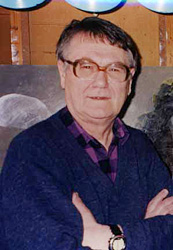
Born: February 24, 1929, Sanok, Poland
Died: February 21, 2005, Warsaw, Poland
Summary. Beksinski was a secluded man. He did not appear in public, and did not exhibit his paintings. When museums or collectors exhibit them he did not show up. He worked on his paintings twelve hours a day against a background of classical music. They are always painted on hardboard, signed on the back, and they bear no titles. Beksinski has never left Poland, didn't speak any foreign language and has never been a member of any ideological group; he hated and despised politics. Beksinski also enjoyed a large following outside Poland mainly in France, Japan and the United States among fans of surrealist art and collectors”, said James Cowan, the president of Morpheus Fine Art, which published a book on Beksinski and has sold some of his works.
Early days. His father was a surveyor. Under the German occupation Beksinski continued his studies at a secondary level, first in a school of commerce, then in a clandestine high school. In 1951 Beksinski married Zofia Stankiewicz. After studying architecture in Cracow Academy of Mines (1947-1952), he returned to Sanok in 1955. Subsequent to this education, he spent several years as a construction site supervisor, which he hated.
Artistic career. In 1960 he became interested in artistic photography and photomontage, sculpture and painting. He made his sculptures of plaster, metal and wire. His photography had several themes that would also appear in his future paintings, presenting wrinkled faces, landscapes and objects with a very bumpy texture, which he attempted to emphasize (especially by manipulating lights and shadows). His photography also depicted disturbing images, such as a mutilated baby doll with its face torn off, portraits of people without faces or with their faces wrapped in bandages. Later, he concentrated on painting. His first paintings were abstract art, but throughout the 1960s he made his surrealist inspirations more visible. In the 1970s, he entered what he himself called his "fantastic period", which lasted up to the late 1980s. This is his best-known period, during which he created very disturbing images, showing a surrealistic, post-apocalyptic environment with very detailed scenes of death, decay, landscapes filled with skeletons, deformed figures and deserts. These paintings were quite detailed, painted with his trademark precision (particularly when it came to rough, bumpy surfaces). His highly-detailed drawings are often quite large, and may remind some of the works of Ernst Fuchs in their intricate and nearly obsessive rendering. Despite the grim overtones, he claimed some of these paintings were misunderstood; in his opinion, they were rather optimistic or even humorous. His exhibitions almost always proved very successful. A prestigious exhibition in Warsaw in 1964 proved to be his first major success, as all his paintings were sold. In the 1980s, his works gained on popularity in France due to the endeavors of Piotr Dmochowski, and he gained significant popularity in Western Europe, the United States and Japan. Beksiński eventually threw himself into painting with a passion, and worked constantly He soon became the leading figure in contemporary Polish art. Before moving to Warsaw in 1977, he burned a selection of his works in his own backyard, without leaving any documentation on them. He later claimed that some of those works were "too personal", while others were unsatisfactory, and he didn't want people to see them. The 1980s marked a transitory period for Beksiński. His art in the early 1990s consisted mainly of a series of surreal portraits and a series of crosses. Paintings in these series were much less lavish than those known from his "fantastic period", but just as powerful. In the latter part of the 1990s, he discovered computers, the Internet, and digital photography, a medium that he focused on until his death. Beksiński always executed his paintings and drawings in either of two manners, which he respectively calls "Baroque" and "Gothic". The first is dominated by representation, the second by form. The late 1990s were a very trying time for Beksiński: his wife, Zofia, died in 1998; a year later, on Christmas Eve 1999, his son Tomasz (a popular radio presenter, music journalist and movie translator) committed suicide. Beksiński discovered his son's body. On 21 February 2005, Beksinski was found dead in his flat in Warsaw with 17 stab wounds on his body; two of the wounds were determined to have been fatal. Robert Kupiec (the teenage son of his long time caretaker), who later pleaded guilty, and a friend were arrested shortly after the crime. Robert Kupiec was sentenced to 25 years of prison, and his accomplice, Łukasz Kupiec, to 5 years.
Honors. Permanent exhibition at the "Toh-Ou Museum" (Museum of East Europe) Osaka. Japan. Permanent exhibition at the Historical Museum. Sanok. Poland. Permanent exhibition at the "Dmochowski Gallery". Paris. France.
His works hang in the National Museum in Wroclaw, the National Museum in Warsaw and in a dedicated museum in his hometown Sanok. .. "Zdzislaw Beksinski won our imagination and the hearts of everyone the public and the critics," Zacheta Gallery director Agnieszka Morawinska told PAP.
This article uses, among others, material from the Wikipedia article "Zdzislaw Beksinski" licensed under the GNU Free Documentation License. :
Wikipedia
Other sources:
A book about Beksinski authored by Beksinski
Morpheus Gallery- some photos of his work.
Gallery: 145 photos of his paintings
Gnosis: about 140 photos of his works
NNDB
Journal Star
Return to home page:
Prominent Poles